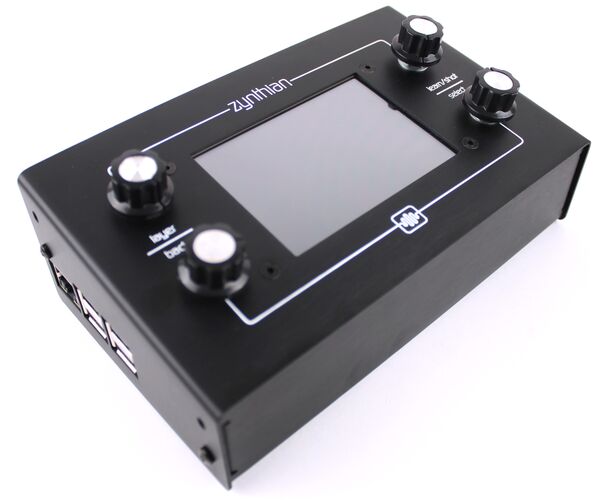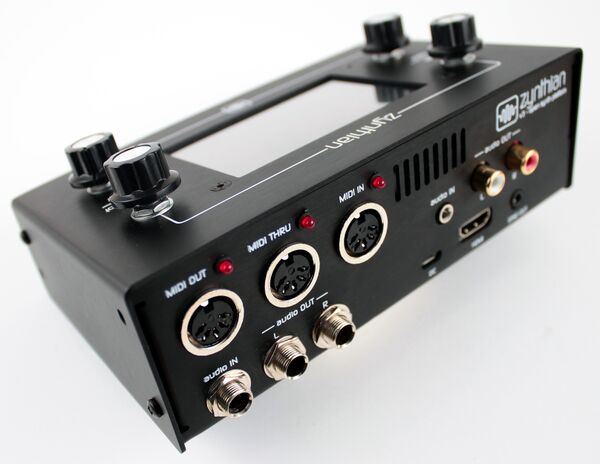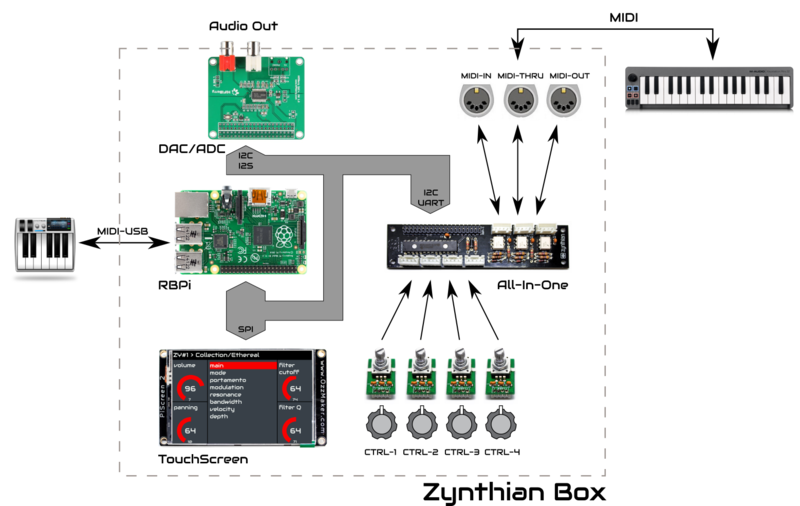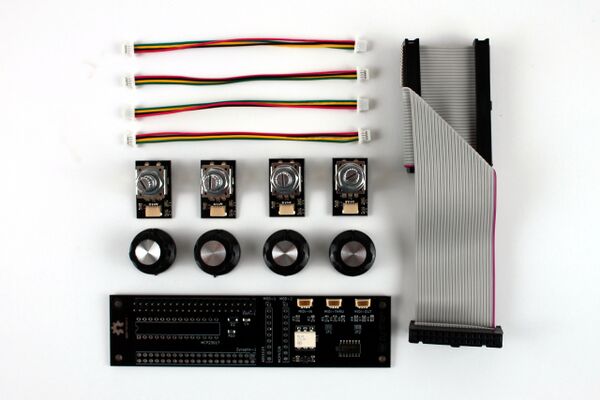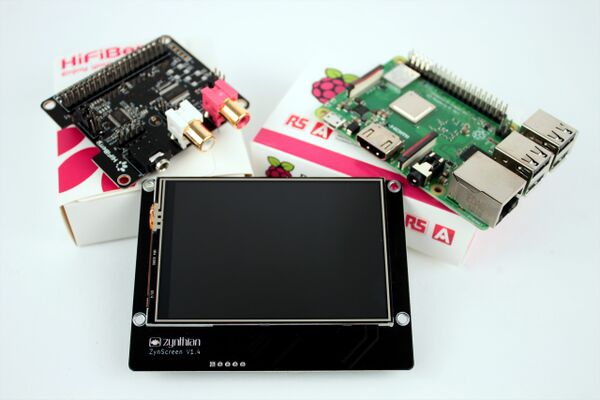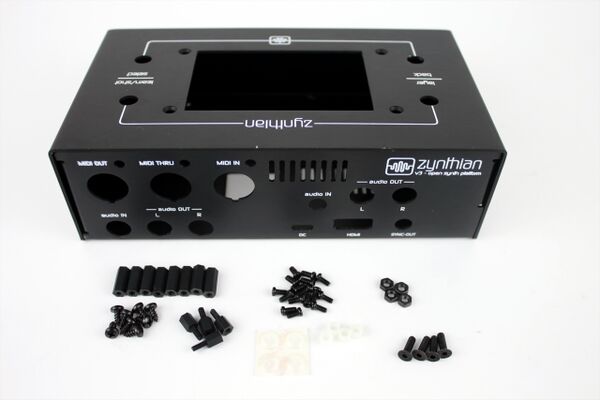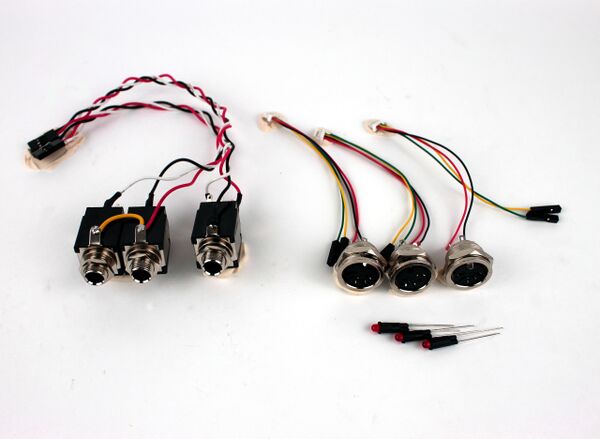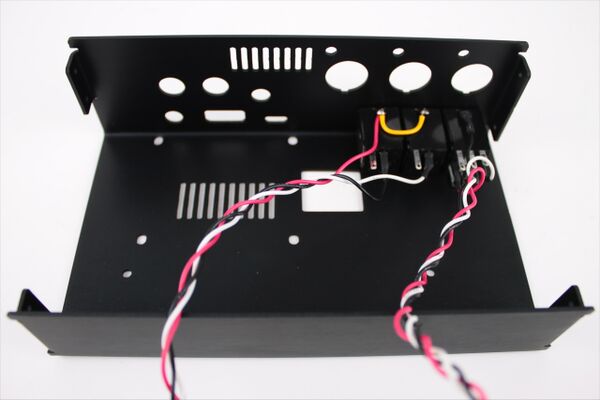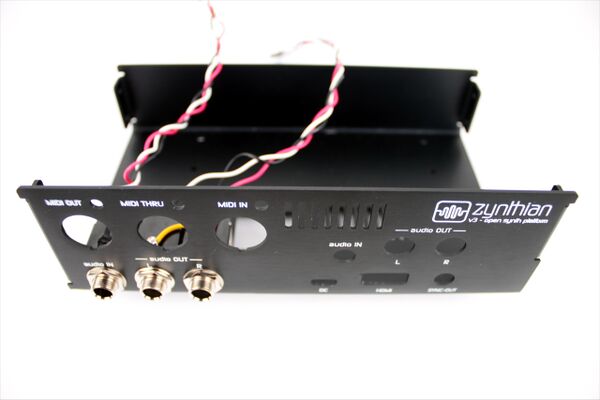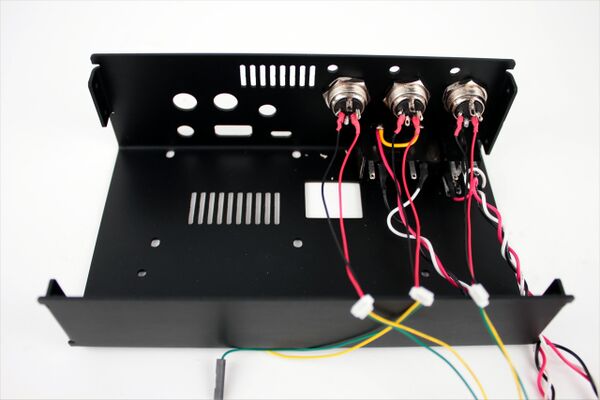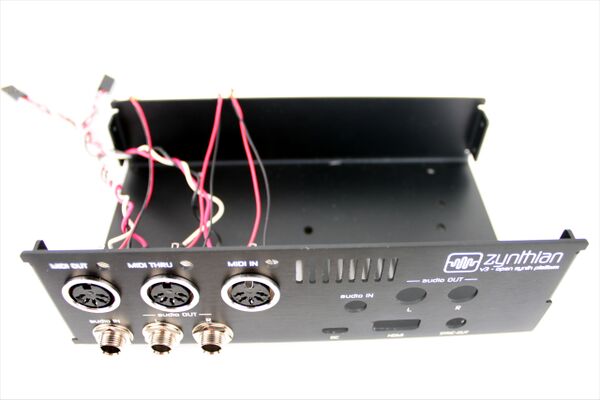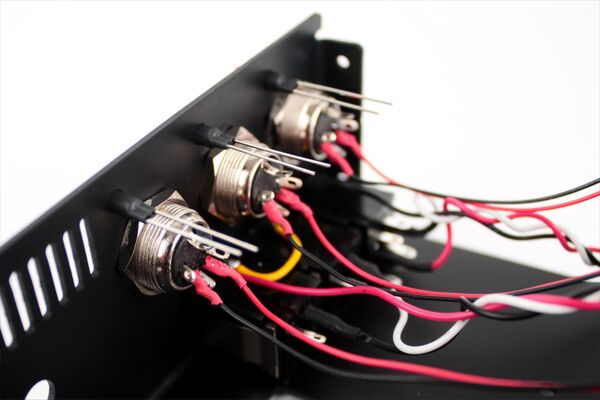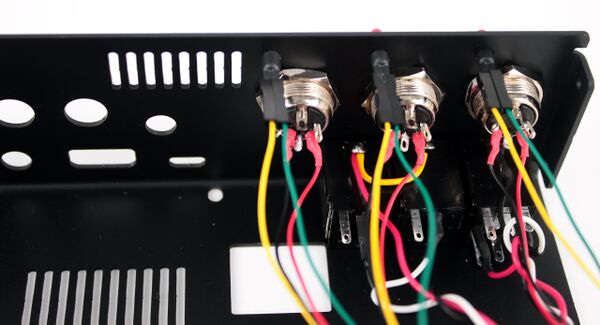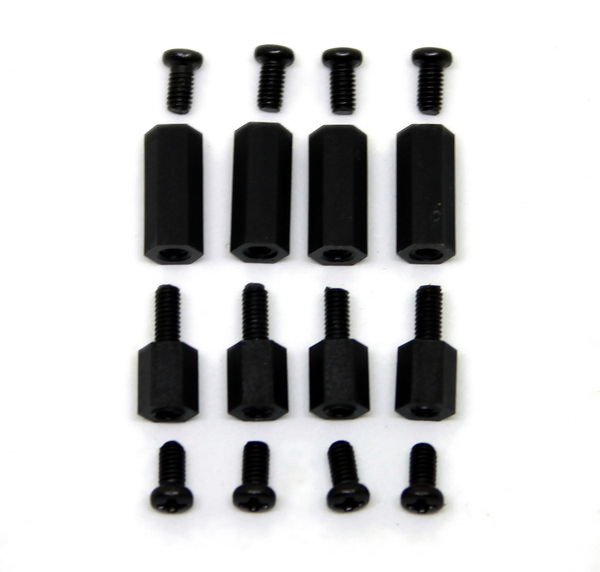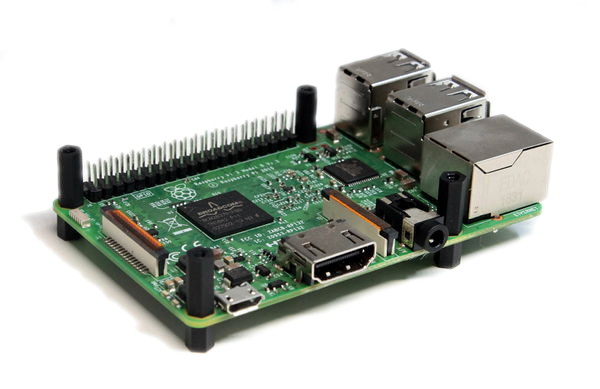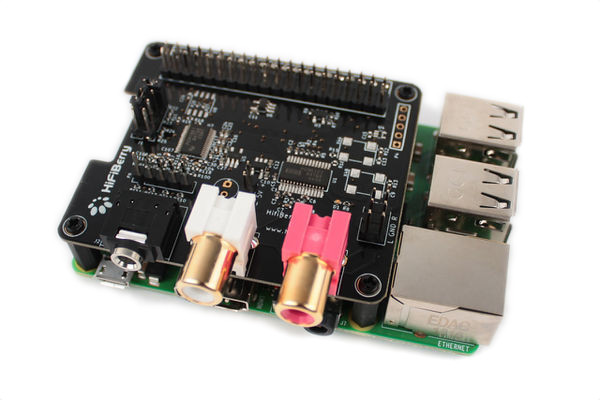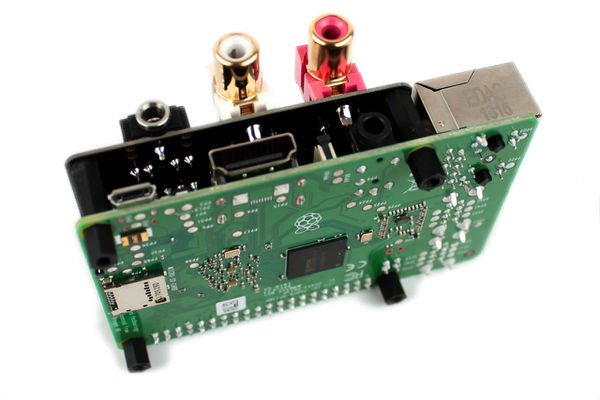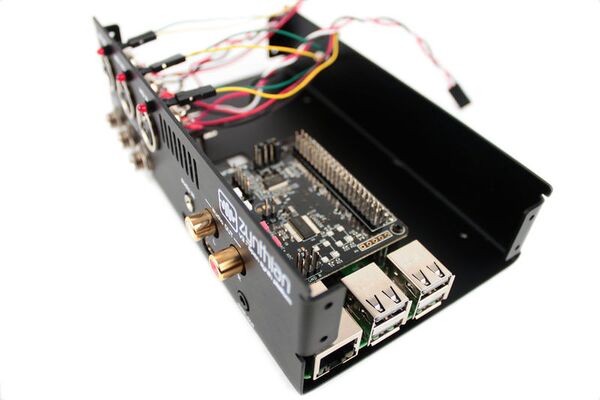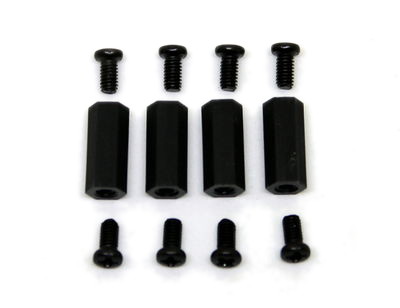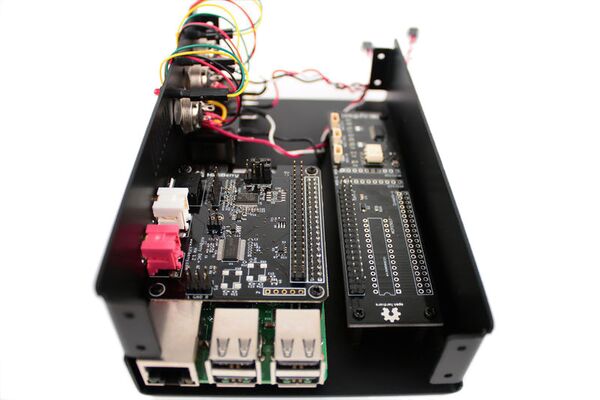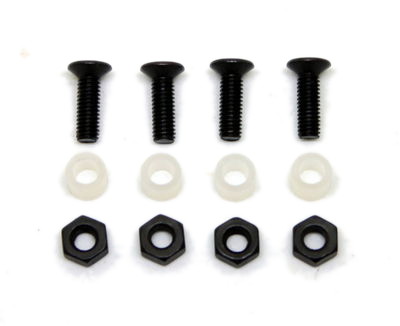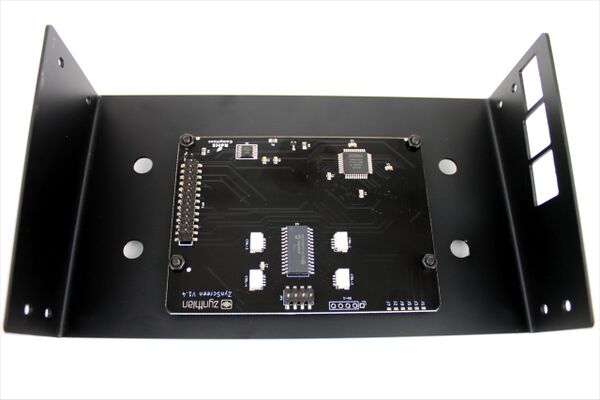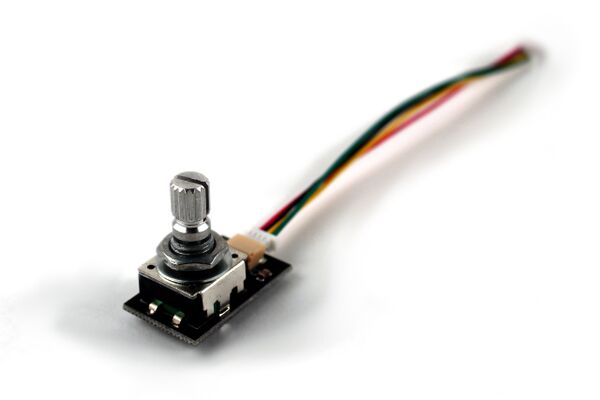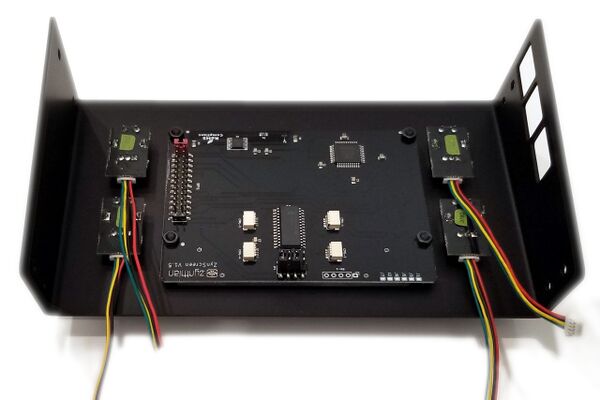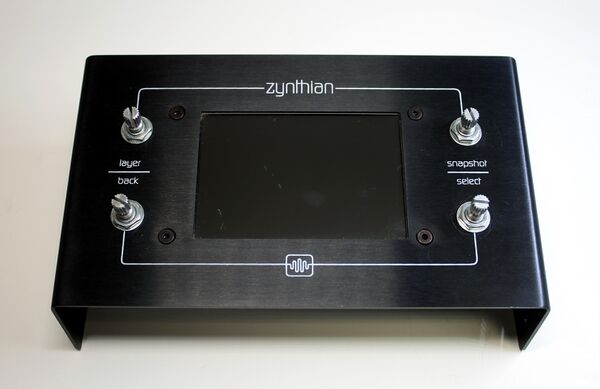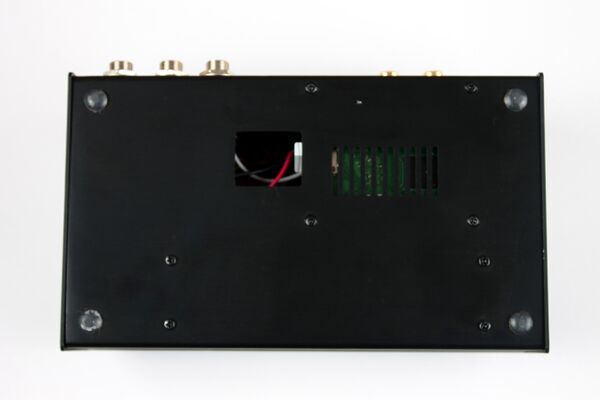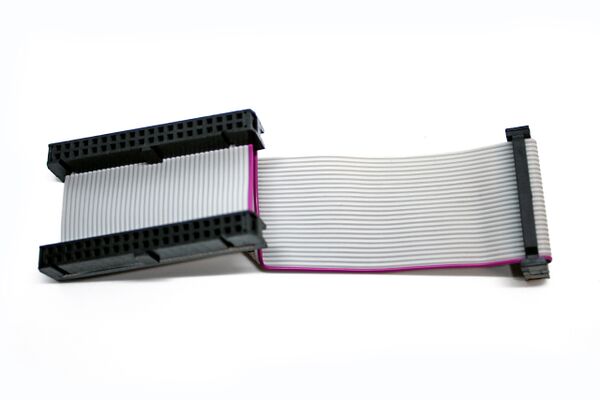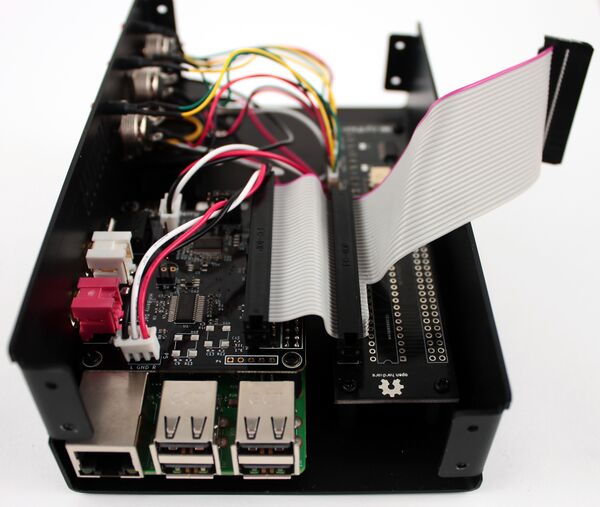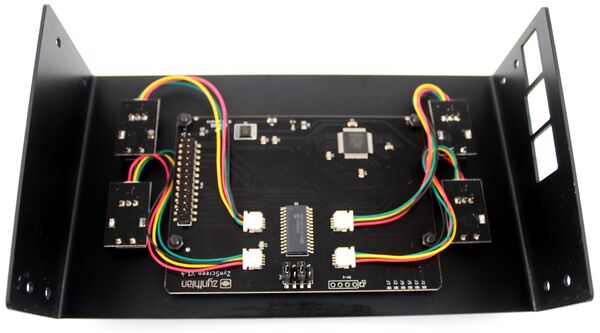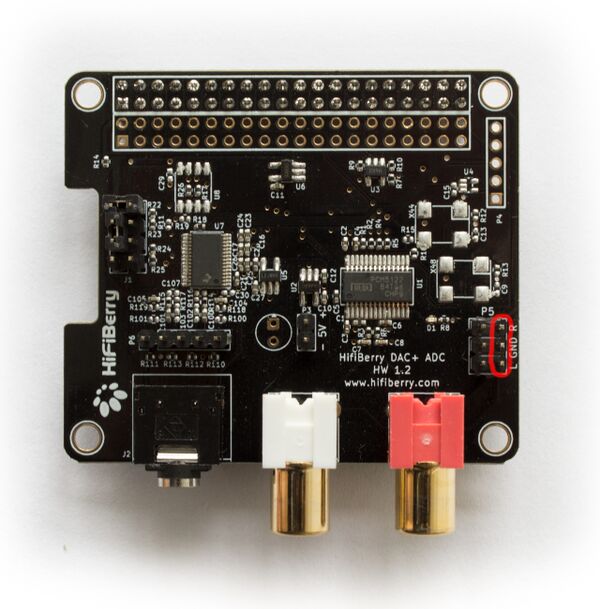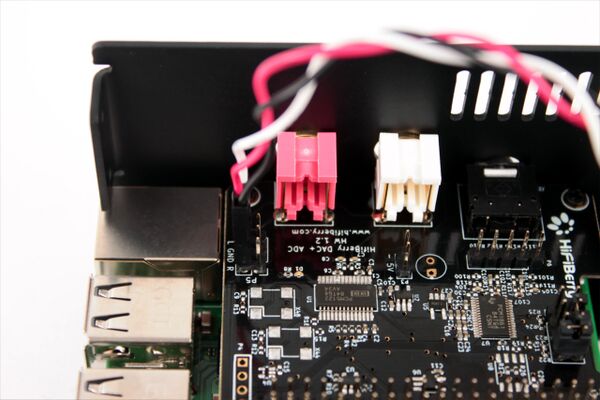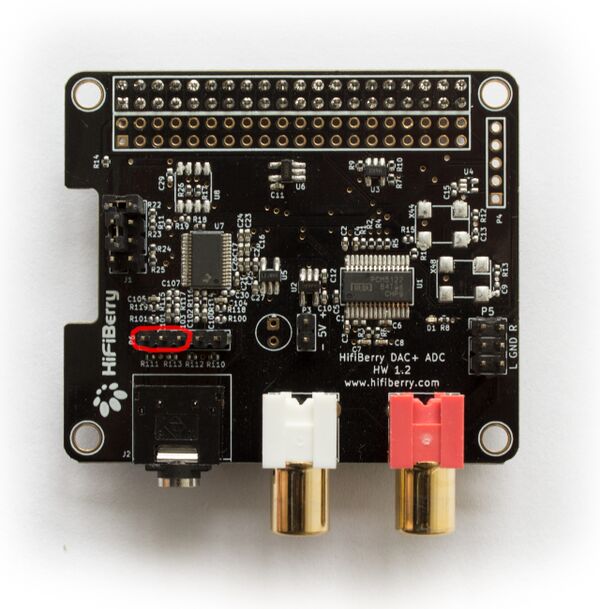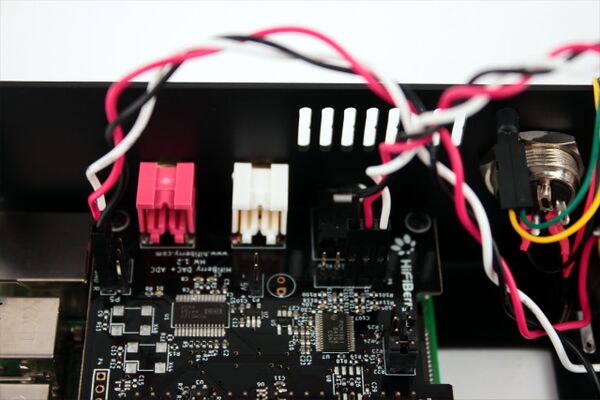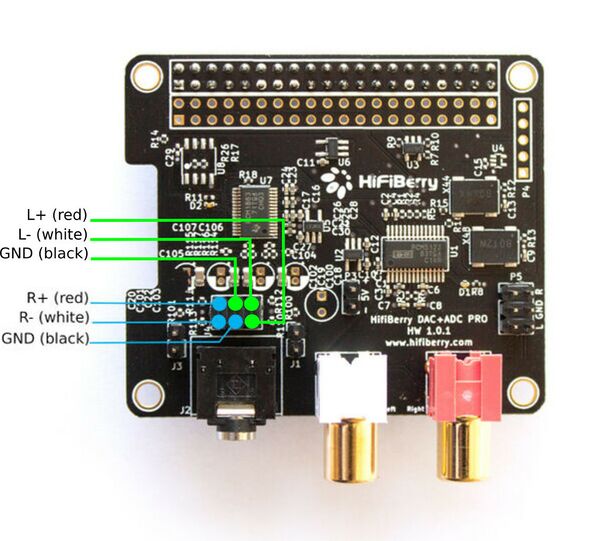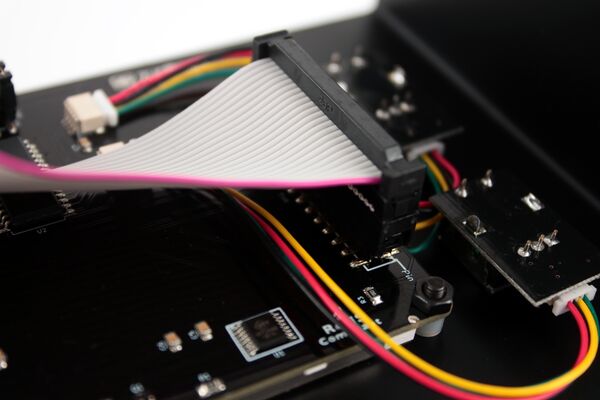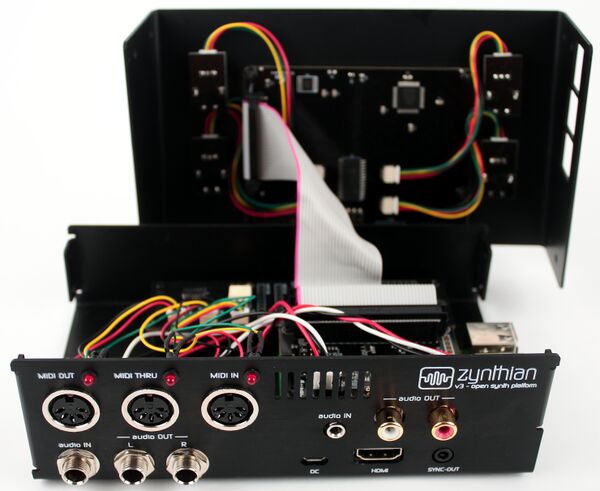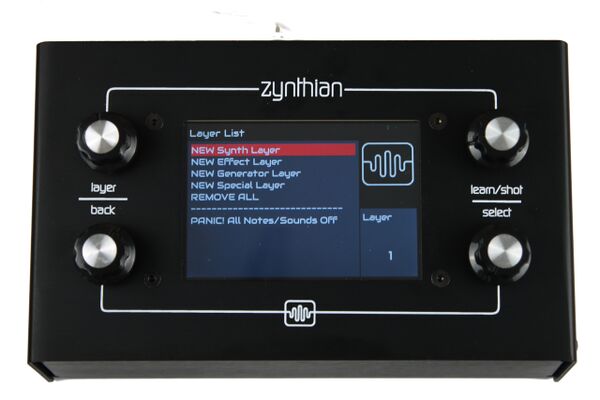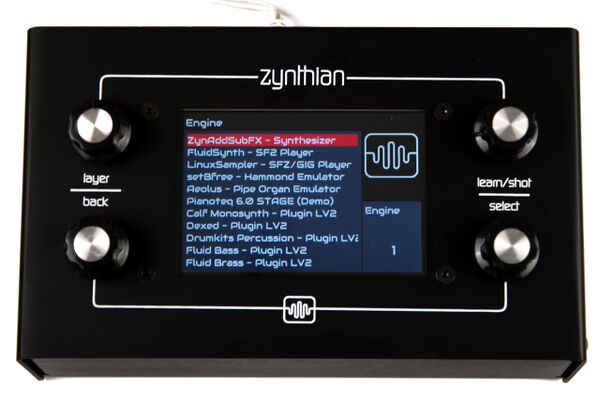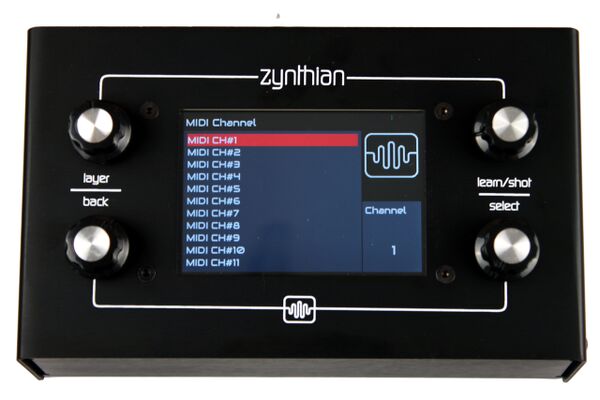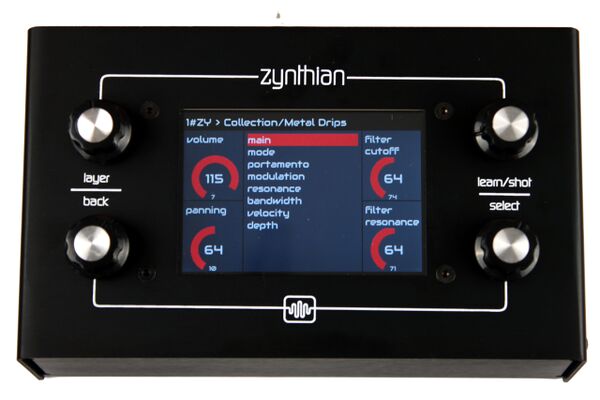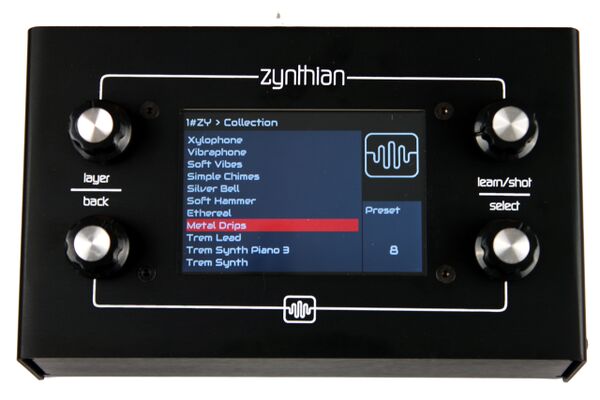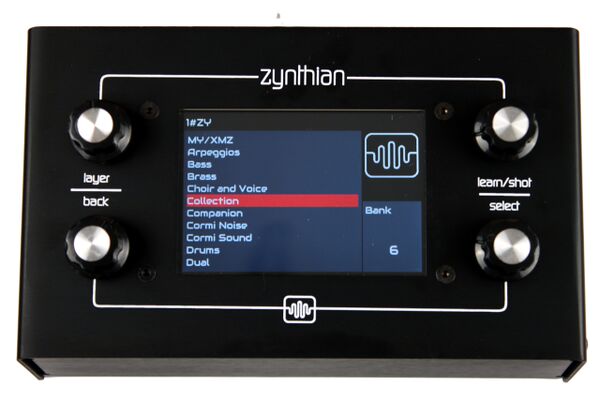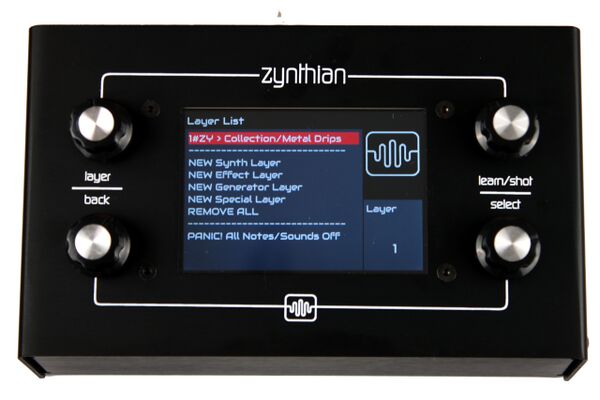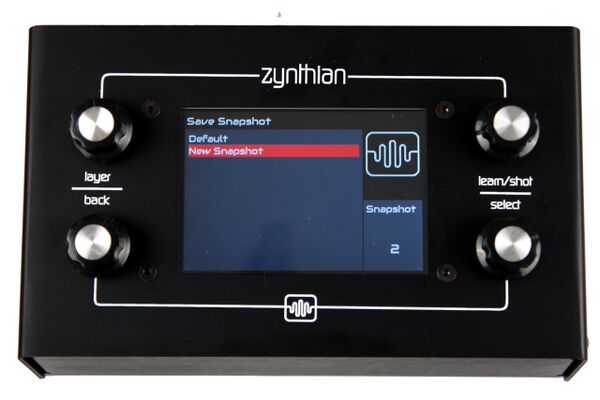Difference between revisions of "Building a Zynthian Box using an official Kit v3"
| (151 intermediate revisions by 3 users not shown) | |||
| Line 2: | Line 2: | ||
=Introduction= | =Introduction= | ||
| − | This tutorial is | + | This tutorial is intended for those who are building a Zynthian Box using one of the ''official'' kits, that i offer here: |
[http://shop.zynthian.org Zynthian Shop] | [http://shop.zynthian.org Zynthian Shop] | ||
| − | Specifically, | + | Specifically, these instructions are for assembling kit v3 (version 3), those kits using the Zynaptik circuit and the ZynScreen v1.4 display. |
| − | |||
| − | + | [[File:ZynthianFront.jpg|600px]] | |
| − | [[File: | + | [[File:ZynthianBack.jpg|600px]] |
| − | = | + | =List of Materials= |
| − | * Zynthian Basic Kit ( | + | * Zynthian Basic Kit v3 (4 x controller v3 + zynaptic circuit + ribbon bus cable) |
| − | * | + | * ZynScreen v1.4 (3.5" touch-display + controller driver) |
| − | * Raspberry | + | * [https://www.raspberrypi.org/products/ Raspberry 3 Model B or B+] |
* [https://www.hifiberry.com/products/dacplus HifiBerry DAC+ADC souncard] | * [https://www.hifiberry.com/products/dacplus HifiBerry DAC+ADC souncard] | ||
| − | * | + | * Case kit v3, including nuts, bolts and connectors |
* Power adapter for Raspberry Pi (5.1v 2.4A with microUSB connector) | * Power adapter for Raspberry Pi (5.1v 2.4A with microUSB connector) | ||
| − | * 16GB SD Card (a | + | * 16GB SD Card (Use a high-quality card) |
| − | |||
| − | |||
=Some definitions= | =Some definitions= | ||
| Line 29: | Line 26: | ||
===Zynthian=== | ===Zynthian=== | ||
| − | It's an open project with the goal of creating an Open Synth Platform based in Free Software and Open Hardware Specifications & Designs (when available | + | It's an open project with the goal of creating an Open Synth Platform based in Free Software and Open Hardware Specifications & Designs (when available) |
===Zynthian Software=== | ===Zynthian Software=== | ||
| Line 37: | Line 34: | ||
+ '''GNU Linux Operating System:''' Raspbian Jessie (Minibian is used in the most recent SD images) | + '''GNU Linux Operating System:''' Raspbian Jessie (Minibian is used in the most recent SD images) | ||
+ '''Jack Audio Daemon''' | + '''Jack Audio Daemon''' | ||
| + | + A collection of standalone '''Synth Engines & LV2 Plugins''' (see [[Zynthian_Supported_Synth_Engines|Supported Synth Engines & Plugins]]) | ||
+ '''MOD-HOST + MOD-UI''' software, from [http://moddevices.com ModDevices] ([https://github.com/moddevices github repositories]) | + '''MOD-HOST + MOD-UI''' software, from [http://moddevices.com ModDevices] ([https://github.com/moddevices github repositories]) | ||
| − | |||
+ '''Zynthian User Interface''' ([https://github.com/zynthian/zynthian-ui github repository]) | + '''Zynthian User Interface''' ([https://github.com/zynthian/zynthian-ui github repository]) | ||
| + | + '''Zynthian Webconf Tool''' ([https://github.com/zynthian/zynthian-webconf github repository]) | ||
| − | All the software used by Zynthian is Free Software (free as in ''freedom'', not as in ''free beer'') and it's covered by the GPL license or similar. If you don't know what | + | All the software used by Zynthian is Free Software (free as in ''freedom'', not as in ''free beer''), and it's covered by the GPL license or similar. If you don't know what Free Software is, take a look at this link: |
[https://www.gnu.org/philosophy/free-sw.en.html What is Free Software?] | [https://www.gnu.org/philosophy/free-sw.en.html What is Free Software?] | ||
| Line 47: | Line 45: | ||
The easiest way of getting the software is downloading the last ''official'' SD image from here: | The easiest way of getting the software is downloading the last ''official'' SD image from here: | ||
| − | '''[ | + | '''[https://os.zynthian.org/zynthianos-last-stable.zip Download Last Stable ZynthianOS SD-image]''' |
| − | It's a | + | It's a 8 GB compressed image file (plenty of soundfonts) compiled for Raspberry Pi 3. |
| − | These SD card images include all the Zynthian software, properly configured for working with the official kits. Completely ready to use. Plug and play! | + | These SD-card images include all the Zynthian software, properly configured for working with the official kits. Completely ready to use. Plug and play! |
| − | After downloading the SD-image, you have to write it to | + | After downloading the SD-image, you have to write it to your micro-SD card. You need a '''micro-SD card with a minimum size of 16 GB'''. |
| − | If you don't know how to do it, you can use [https://etcher.io/ Etcher] (free software works on Mac, Windows or Linux) to flash the image onto the | + | If you don't know how to do it, you can use [https://etcher.io/ Etcher] (free software, works on Mac, Windows or Linux) to flash the image onto the micro-SD card. Or do it manually! There is a really good manual for this at [https://www.raspberrypi.org/documentation/installation/installing-images/ this link]. |
| − | + | you can also build your own SD image following these instructions: | |
[https://discourse.zynthian.org/t/new-sd-image-setup-script/283 Building the SD Image using the Setup Script] | [https://discourse.zynthian.org/t/new-sd-image-setup-script/283 Building the SD Image using the Setup Script] | ||
| Line 63: | Line 61: | ||
===Zynthian Box=== | ===Zynthian Box=== | ||
| − | A Zynthian Box is a hardware device, a small digital computer designed to run the Zynthian Software. | + | A Zynthian Box is a hardware device, a small digital computer designed to run the Zynthian Software. It's currently based on the Raspberry Pi platform, but it could easily be adapted to other computer platforms. |
| − | This is a sketch with the | + | This is a sketch with the components the ''official'' Zynthian Box is made of: |
[[File:Zynthian_hardware_scheme.png|800px]] | [[File:Zynthian_hardware_scheme.png|800px]] | ||
| − | In the project's repositories you | + | In the project's repositories you can find all the electric schemes, PCB specifications, Herber files, etc. to build your own Zynthian Box from scratch: |
- [https://github.com/zynthian/zynthian-hw Zynthian Hardware Repository] | - [https://github.com/zynthian/zynthian-hw Zynthian Hardware Repository] | ||
- [https://github.com/zynthian/zynthian-case Zynthian Case Repository] | - [https://github.com/zynthian/zynthian-case Zynthian Case Repository] | ||
| − | The ''official'' version is the canonical reference. Of course, you don't have to build the ''official'' version. You can build your customized Zynthian Box modifying and improving what you want. If you do so, | + | The ''official'' version is the canonical reference. Of course, you don't have to build the ''official'' version. You can build your customized Zynthian Box modifying and improving what you want. If you do so, feedback would be appreciated. |
| − | ===Zynthian Kit=== | + | ===Zynthian Bundle All Kit v3=== |
| − | A Zynthian Kit is a set of | + | A Zynthian Kit is a set of electronic and mechanic parts. The ''official'' Zynthian Bundle All Kit v3 consists of these specific parts: |
| − | + '''4 x Controller Modules''' | + | + '''4 x Controller Modules + Wiring''' |
| − | + '''1 x | + | + '''1 x Zynaptik Module:''' MIDI Ports + extended I/O |
| + | + '''1 x ZynScreen 3.5':''' Touch-Display + Controllers circuit | ||
+ '''1 x Main ribbon bus cable''' | + '''1 x Main ribbon bus cable''' | ||
| − | |||
| − | [[File: | + | [[File:IMG_2461.JPG|600px]] |
| − | + | These generic parts: | |
| − | + '''1 x Raspberry Pi | + | + '''1 x Raspberry Pi 3''' |
| − | + '''1 x Hifiberry DAC+ | + | + '''1 x Hifiberry DAC+ADC''' |
| − | |||
| − | [[File: | + | [[File:IMG_2377.JPG|600px]] |
| + | And the aluminium case: | ||
| − | + | + '''1 x Zynthian Aluminium Case''' | |
| + | + '''1 x Connectors''' | ||
| + | + '''1 x Bolts & Nuts''' | ||
| − | + | [[File:IMG_2379.JPG|600px]] | |
| − | + | [[File:IMG_2384.JPG|600px]] | |
| − | |||
| − | |||
| − | === | + | ==== Unboxing the Official Kit V3, by Sébastien Marty ==== |
| − | + | <embedvideo service="youtube">https://www.youtube.com/watch?v=dFTSyUoUUTQ</embedvideo> | |
| − | + | =Assembling your Zynthian Box= | |
| − | + | ===Prerequisites=== | |
| − | |||
| − | |||
| − | |||
| − | |||
| − | |||
| − | + | Assembling your Zynthian Kit V3 is not difficult at all: you need your attention, a screwdriver, and an adjustable wrench. You don't need to solder anything, just put it together and connect the wires. | |
| − | + | Read the instructions and observe the detailed photos carefully. If you get in trouble you can ask the community: | |
| − | |||
| − | |||
https://discourse.zynthian.org | https://discourse.zynthian.org | ||
| − | + | {{WarningBox|Please, handle electronic parts with care, specially the display, as they are easily damaged.}} | |
| − | + | ===Secure the Jack connectors=== | |
| − | + | Insert the jack connectors from inside the box and secure them with the washers and nuts from the inside. The washers will keep the nut from damaging the case. | |
| − | |||
| − | |||
| − | + | [[File:IMG_2397.JPG|600px]] | |
| + | [[File:IMG_2398.JPG|600px]] | ||
| − | === | + | ===Secure the MIDI connectors=== |
| − | + | Insert each MIDI connector, from the outside and secure them with the bolt from the inside. | |
| − | + | [[File:IMG_2401.JPG|600px]] | |
| − | + | [[File:IMG_2402.JPG|600px]] | |
| − | |||
| − | |||
| − | |||
| − | |||
| − | |||
| − | |||
| − | |||
| − | |||
| − | |||
| − | |||
| − | === | + | ===Mount the MIDI activity LEDS=== |
| − | |||
| − | |||
| − | + | Insert the 3 LEDS in the case from the outside, leaving the short lead at left. Make sure you push the LEDs by the plastic around the LED, not the LED itself. | |
| − | + | [[File:IMG2403.JPG|600px]] | |
| − | |||
| − | ' | + | When it's done, you have to plug the LED wires into the 2 spare "DUPONT" connectors from the MIDI harness (green & yellow wires). Polarity is important, so don't cross the wires: |
| − | |||
| − | == | + | * JST Green wire (1) => LED's Anode (LED's long lead) |
| + | * JST Yellow wire (2) => LED's Cathode (LED's short lead) | ||
| − | + | Since the LED's leads are too long, you will want to cut them down to about 7-8mm. Make sure you remember which lead is the short one. | |
| − | + | [[File:IMG2406.JPG|600px]] | |
| − | |||
| − | |||
| − | |||
| − | |||
| − | + | {{NoteBox|If you don’t connect the status LEDs, the MIDI-OUT and MIDI-THRU won’t work unless you short the JP1 & JP2 jumpers on the zynaptik board.}} | |
| − | + | ===Assemble the Main Computing Block=== | |
| − | + | The main computing block consists of the Raspberry Pi and the HifiBerry soundcard,and is assembled using these separators and bolts | |
| − | + | [[File:IMG_1293.JPG|600px]] | |
| − | + | 1. Fix the 2x4 separators to the Raspberry Pi. Put the longest of the two on top of the Pi and she shorter at the bottom. | |
| − | 1. | + | 2. Connect the Hifiberry soundcard to the Raspberry Pi. |
| − | 2. | + | 3. Fix the 4 screws on top of the HifiBerry to fix it in place. |
| − | |||
| − | 3. | ||
| − | |||
| − | |||
| − | |||
| − | [[File: | + | [[File:IMG_1353.JPG|600px]] |
| − | + | [[File:IMG_2393.JPG|600px]] | |
| − | + | [[File:IMG_2395.JPG|600px]] | |
| − | + | ===Secure the Main Computing Block=== | |
| − | |||
| − | |||
| − | |||
| − | |||
| − | |||
| − | |||
| − | |||
| − | |||
| − | |||
| − | |||
| − | |||
| − | |||
| − | |||
| − | + | After assembling the main computing block, secure it to the case. Use the 4 remaining black M2.5 screws to secure it to the bottom of the case (see photo above). | |
| − | |||
| + | [[File:IMG 2407.JPG|600px]] | ||
| − | + | ===Secure the Zynaptik module=== | |
| − | + | Secure the Zynaptik module to the case using 4 x separators and 8 x M2.5 screws. Begin by mounting the separators to the bottom of the case, and attach the module to the separators using the remaining screws. | |
| − | |||
| − | |||
| − | |||
| − | |||
| − | |||
| − | |||
| − | + | [[File:IMG_1294.JPG|400px]] | |
| − | [[File: | + | [[File:IMG_2410.JPG|600px]] |
| − | + | The zynaptik board has some extra circuitry which doesn't have anything soldered on it. These are used for adding extra functionality to the board. | |
| − | + | ===Mount the Display=== | |
| − | + | {{WarningBox|Please, handle electronic parts with care, specially the display, as it is easily damaged.}} | |
| − | + | The screen is secured with these 4 screws, nuts, and nylon separators. Mount the screen by screwing the screws from the outside and fixing them with the bolts from the inside. The separators go between the screen and the case. Remember to remove the protective film from the screen before mounting it. | |
| − | + | [[File:IMG_1295.JPG|400px]] | |
| − | |||
| − | + | [[File:IMG_2423.JPG|600px]] | |
| − | + | ===Mount the Controllers=== | |
| − | + | Plug a wire on each controller. Fix the controllers in each corner using the nuts and washers attached to them | |
| − | [[File: | + | [[File:Rotary&wire.JPG|600px]] |
| − | + | [[File:ZynScreen&Controller.JPG|600px]] | |
| − | + | [[File:IMG_1401.JPG|600px]] | |
| − | + | ===Attach the knobs=== | |
| − | + | You should attach the knobs into the encoders before closing the case. Push the knobs unto the encoders while pushing the encoder with a finger on the PCB board. This will avoid putting too much pressure on the encoders, which can break them. The knobs can be very tight, and a bit of water can be used as lubricant to help with this. | |
| − | + | ===Attach the rubber feet=== | |
| − | + | [[File:IMG 2536.JPG|600px]] | |
| − | + | =Connecting everything= | |
| − | |||
| − | == | ||
| − | |||
| − | |||
| − | + | The Zynthian Kit 3 is designed to use JST connectors which can't be plugged in wrong, so connecting everything is straight-forward: | |
| − | + | ===Connect the Ribbon Bus cable=== | |
| − | + | Connect the Main Ribbon Bus cable to the Raspberry Pi's 40-pin header and to the Zynaptik module. The red wire is pin 1, so if you are looking at the case from the front, it should be on the right. | |
| − | |||
| − | |||
| − | |||
| − | + | [[File:Ribbon.jpeg|600px]] | |
| + | [[File:Ribbon&Hifi&Zynaptik.JPG|600px]] | ||
| − | + | ===Connect the Controllers=== | |
| + | Connect the 4 controller cables to the 4 controller connectors on the ZynScreen (CTRL1, CTRL2, CTRL3, CTRL4) | ||
| − | + | [[File:ZynScreenConnect.JPG|600px]] | |
| − | === | + | ===Connect the MIDI connectors & activity LEDs=== |
| − | + | Connect the 3 cables from the MIDI connectors to the MIDI-IN, MIDI-OUT and MIDI-THRU connectors on the Zynaptik module. | |
| − | [[File: | + | [[File:MIDIConnector.JPG|600px]] |
| − | + | {{NoteBox|If you don’t connect the status LEDs, the MIDI-OUT and MIDI-THRU won’t work unless you short the JP1 & JP2 jumpers on the zynaptik board.}} | |
| − | = | + | ===Connect the Audio Output Jack connectors=== |
| − | + | Connect the audio output jack connectors to the audio-output header to the Hifiberry soundcard: | |
| − | + | [[File:dacplus-adc-top audio-out.jpg|600px]] | |
| + | [[File:IMG_2414.JPG|600px]] | ||
| − | + | The black wire on the "R" pin, white on the "L" one and red on "GND" (middle). | |
| − | + | {{NoteBox|Some kits have flipped the red and white wires. This is not a problem. Simply look at the black wire.}} | |
| − | + | ===Connect the Audio Input Jack connector=== | |
| − | |||
| − | |||
| − | + | This step depends of the specific model of your soundcard: | |
| − | + | ====HifiBerry DAC+ADC Standard==== | |
| − | + | Connect the input jack connector to the audio-input header on the sound card using the 3-pin Dupont connector: | |
| − | + | [[File:dacplus-adc-top audio-in.jpg|600px]] | |
| + | [[File:IMG_2416.JPG|600px]] | ||
| − | + | The black wire should be connected to pin 3, red wire to pin 2 and white wire to pin 1. Looking at the first photo, numbering is left to right. | |
| − | [[ | + | {{NoteBox|Some kits have flipped the red and white wires. This is not a problem. Simply look at the black wire.}} |
| + | |||
| + | |||
| + | {{WarningBox|Due to hardware problems, Hifiberry has recently changed (September 2019) [https://www.hifiberry.com/docs/data-sheets/datasheet-dac-adc the specification of the DAC+ADC]. It seems that the Balanced Audio input doesn't work as expected. Instead it works like a simple not-balanced input. You can read more about this subject on [https://discourse.zynthian.org/t/new-official-kit-v2-audio-input-is-here/3013/25 this forum thread]. | ||
| + | <br> | ||
| + | In order to take advantage of the stereo connector, which should be a mono balanced input but isn't, you can get an unbalanced stereo input by connecting both audio channels to the connector. The problem is that the 3-wire Dupont connector included in official kit. You have to cut the second wire (red or white) and solder a single Dupont connector, connecting it to the pin 5 on the Hifiberry. Please check the [https://www.hifiberry.com/docs/data-sheets/datasheet-dac-adc/ Hifiberry DAC+ADC specification]}} | ||
| − | === | + | ====HifiBerry DAC+ADC PRO==== |
| − | + | Connect the input jack connector to the audio-input header on the sound card using the three 1-pin Dupont connectors as indicated in the image: | |
| − | [[File: | + | [[File:dacplusadcpro-top-audio-in.jpg|600px]] |
| − | [ | + | This way you will have the balanced input connected on the Right channel. If you want to use the Left channel, take a look at the [https://www.hifiberry.com/docs/data-sheets/datasheet-dac-adc-pro Hifiberry DAC+ADC PRO specification]. |
| − | === | + | ===Connect the Display=== |
| − | + | connect the ribbon's 26-pin connector to the display's connector. '''Pay attention to the orientation'''. The red wire should be the pin 1, which as marked on the display's PCB surface. | |
| − | [[File: | + | [[File:Screen&Ribbon.JPG|600px]] |
| − | |||
| − | + | At this point, your Zynthian Box should look like this: | |
| − | |||
| + | [[File:Precierre.JPG|600px]] | ||
| − | === | + | === Building and Testing the Official Kit V3, by Sébastien Marty === |
| − | + | <embedvideo service="youtube">https://www.youtube.com/watch?v=e5gpAZL8kiE</embedvideo> | |
| − | + | =Testing your Zynthian Box= | |
| − | |||
| − | + | And that's all. Your Zynthian Box is almost ready to boot. I recommend that you double-check everything before trying to boot. | |
| − | + | ===Double-check the parts and wiring=== | |
| − | |||
| − | + | It's easy to make a mistake while assembling the parts or connecting the wires. Some errors can be dangerous for the electronic components (such as short circuits) so it's better to be sure that everything is correctly assembled and connected. | |
| − | + | Pay attention to ribbon bus connection and verify that red wire is on pin 1 for every connector. Pay attention to the audio jack connectors and make sure they are connected correctly to the Hifiberry sound card. | |
| − | === | + | ===First Boot=== |
| − | + | When you are sure that everything is in its place, it's time to boot the machine: | |
| − | [[ | + | 1. Insert the SD-card with the zynthian image. If you don't have one yet, [[#Zynthian_Software|read this]]. You can insert the SD-card through the "window" on the bottom-side of the case. |
| + | 2. Plug the mini-usb power connector. A good 5V micro-usb charger is recommended (> 2 Amp). | ||
| − | + | These are the stages that you should see while booting: | |
| − | + | 1. After 5-10 seconds, it will show the Zynthian splash screen | |
| + | 2. After 3-4 seconds, it will go black | ||
| + | 3. If you are using a fresh zynthian image and it's the first boot, the stages 1 and 2 will be repeated | ||
| + | 4. After 5-10 seconds, the zynthian UI will be shown | ||
| − | + | If you get the Zynthian UI, then you have assembled the Zynthian box correctly. Congratulations! | |
| − | + | [[file:IMG_2490.JPG|600px]] | |
| − | ' | + | If you don't get an error screen or a blank screen, you probably you made a mistake during the assembly. You have to [[#Locating_and_Solving_problems|locate and solve the problem(s)]]. |
| − | + | If you are using the Aruk RC-3 SD image (which you should), you will notice that the controllers are not working at all. This SD image is pre-configured for working with the kit v2, so you need to configure the software for working with the kit v3. The simplest way of doing it is using the webconf tool: | |
| − | + | * Connect your zynthian to your local network using an ethernet cable (RJ-45). | |
| + | * From your web browser, access the zynthian's webconf tool by typing "zynthian.local" in the address bar. If this doesn't work for you, you should try with the IP. You can get the IP of your zynthian by navigating to the Admin Menu and clicking "Network Info". You should do that by using the touch interface: Click the top bar with a stick (or your nail, if it's not too wide) until you are in the Admin Menu. Once you are there, go down and click "Network Info". | ||
| + | * Type the password (''raspberry'') and log into the webconf tool. | ||
| + | * Once you are logged in, you have to access Hardware->Kit and select "Kit V3". | ||
| + | * Save the changes and reboot your Zynthian. | ||
| − | === | + | ===Test the Controllers & UI=== |
| − | + | If you get into the Zynthian UI, then you should be in the 'Layer list' screen. Let's start testing that your controllers are working OK. | |
| − | + | 1. Rotate the SELECT controller up & down for selecting the different options in the Layers menu. | |
| − | |||
| − | + | 2. Push SELECT to create a New 'Synth Layer'. You should get into the 'Engine Selection' screen. | |
| − | [[File: | + | [[File:IMG_2496.JPG|600px]] |
| − | + | If it doesn't work, try rotating/pushing the 'learn/snapshot' controller. Perhaps you have cross-wired the 3 & 4 controllers and in that case, you have to fix the wiring. If it doesn't work, try pushing the other two controllers and rotating the controllers. If something happens, most probably you have reversed the wiring when connecting the controllers. Double-check the wiring again. | |
| − | + | 3. Rotate the SELECT controller to choose the engine you want to instance for the new layer. | |
| − | + | The selector must go down when rotating clockwise and go up when rotating counter-clockwise. If the rotation sense is reversed, you should check the wiring. Perhaps one of the connections are faulty. The wires' color sequence should be red, black, yellow, green. | |
| − | + | 4. Select the ZynAddSubFX engine, select channel #1, select bank 'Collection' and preset 'Metal Drips'. | |
| − | [[File: | + | [[File:IMG_2497.JPG|600px]] |
| − | + | You should get to the 'Instrument Control' screen. | |
| − | [[File: | + | [[File:IMG_2500.JPG|600px]] |
| − | + | 5. Rotate every control to test that it works and that the rotation sense is correct. | |
| − | + | If one of the controllers doesn't work correctly, check the wiring again. | |
| − | + | 6. Push SELECT to move to the next controller screen. Bold push (a push lasting about 1 second) to select a controller screen from the list. | |
| − | + | 7. Push BACK. You should go back to the 'Preset Selection' screen. | |
| − | [[File: | + | [[File:IMG_2499.JPG|600px]] |
| − | + | 8. Push BACK again. You should go back to the 'Bank Selection' screen. | |
| − | [[File: | + | [[File:IMG_2498.JPG|600px]] |
| − | + | 9. Push LAYER again to return to the 'Layer Selection' screen. Try to create another layer following the same procedure. | |
| − | + | [[File:IMG_2509.JPG|600px]] | |
| − | + | 10. Push 'SNAPSHOT' to get into the 'Snapshot' screen. Select 'New Snapshot' and your first snapshot will be stored. | |
| − | + | [[File:IMG_2506.JPG|600px]] | |
| − | + | If everything is working OK, then you should read the [[Zynthian_Users_Guide|User's Guide]] and start enjoying your Zynthian Box, but before that ... why not enjoy it a little bit? Connect your MIDI keyboard, your speakers and check this out: | |
| − | + | Bank 'net-wisdom', Preset 'Vangelis Saw - C' | |
| − | + | Keep pushing a single note (or a chord) and move the cutoff and resonance controllers. Play around a bit and have some fun | |
| − | |||
| − | |||
| − | |||
| − | |||
| − | |||
| − | |||
| − | |||
| − | |||
| − | |||
| − | |||
| − | |||
| − | |||
| − | |||
| − | |||
| − | |||
| − | |||
| − | |||
| − | |||
| − | |||
| − | |||
| − | |||
| − | |||
| − | |||
| − | |||
| − | |||
| − | |||
| − | |||
| − | |||
| − | |||
| − | |||
| − | |||
| − | |||
| − | |||
| − | |||
| − | |||
| − | |||
| − | |||
| − | |||
| − | |||
| − | |||
| − | |||
| − | |||
| − | |||
| − | |||
| − | |||
| − | |||
| − | |||
| − | |||
| − | |||
| − | |||
| − | |||
| − | |||
| − | |||
| − | |||
| − | |||
| − | |||
| − | |||
| − | |||
| − | |||
| − | |||
| − | |||
| − | |||
| − | |||
| − | |||
| − | |||
| − | |||
===Test the Audio Output=== | ===Test the Audio Output=== | ||
| Line 503: | Line 389: | ||
2. Boot your Zynthian. You should be in the initial 'Layer Selection' screen. | 2. Boot your Zynthian. You should be in the initial 'Layer Selection' screen. | ||
3. Push BACK and you will get into the 'Admin' screen. | 3. Push BACK and you will get into the 'Admin' screen. | ||
| − | 4. Select 'Audio Test' option and push 'SELECT'. You should hear the test audio-track: a nice afrocuban | + | 4. Select 'Audio Test' option and push 'SELECT'. You should hear the test audio-track: a nice afrocuban track |
5. Push 'BACK' to stop the playing, and 'BACK' again to return to the "Layer Selection' screen. | 5. Push 'BACK' to stop the playing, and 'BACK' again to return to the "Layer Selection' screen. | ||
| − | If you hear nothing | + | If you hear nothing, check the amplifier, speakers, cabling, gain, volume, etc. If nothing works, you have to [[#Locating_and_Solving_problems|locate and solve the problem(s)]]. |
===Test the MIDI subsystem=== | ===Test the MIDI subsystem=== | ||
1. Connect the audio output (RCA or Jack connector) to your amplifier or auto-amplified speakers. | 1. Connect the audio output (RCA or Jack connector) to your amplifier or auto-amplified speakers. | ||
| − | 2. Boot your Zynthian, select FluidSynth engine, channel #1 and ' | + | 2. Boot your Zynthian, select FluidSynth engine, channel #1 and 'TimGM6mb' bank. Select an instrument, like "Piano 1". |
| − | 3. You could add more layers | + | 3. You could add more layers to complete the band |
| − | 3. Push BACK, holding the switch | + | 3. Push BACK, holding the switch down for more than 2 seconds. You should get to the 'Admin' screen. |
| − | 4. Select 'MIDI Test' option and push 'SELECT'. You should hear the test midi-track ('Take Five') interpreted by your Zynthian's band | + | 4. Select 'MIDI Test' option and push 'SELECT'. You should hear the test midi-track ('Take Five') interpreted by your Zynthian's band |
5. Push 'BACK' to stop the playing | 5. Push 'BACK' to stop the playing | ||
| Line 522: | Line 408: | ||
1. Connect the audio output (RCA or Jack connector) to your amplifier or auto-amplified speakers. | 1. Connect the audio output (RCA or Jack connector) to your amplifier or auto-amplified speakers. | ||
| − | 2. Boot your Zynthian, select ZynAddSubFX, channel #1, bank and instrument | + | 2. Boot your Zynthian, select ZynAddSubFX, channel #1, bank and an instrument |
3. Connect a MIDI-USB keyboard to any USB port. The keyboard should be configured to use channel #1. | 3. Connect a MIDI-USB keyboard to any USB port. The keyboard should be configured to use channel #1. | ||
| − | 3. After 2-3 seconds , play something with your keyboard. A simple ''Chopin's Nocturni'' | + | 3. After 2-3 seconds , play something with your keyboard. A simple ''Chopin's Nocturni'' should be enough. You should hear your music. If you don't like it, you should probably take some piano lessons, like me. |
If this doesn't work, you have to [[#Locating_and_Solving_problems|locate and solve the problem(s)]]. | If this doesn't work, you have to [[#Locating_and_Solving_problems|locate and solve the problem(s)]]. | ||
| Line 531: | Line 417: | ||
1. Connect the audio output (RCA or Jack connector) to your amplifier or auto-amplified speakers. | 1. Connect the audio output (RCA or Jack connector) to your amplifier or auto-amplified speakers. | ||
| − | 2. Boot your Zynthian, select ZynAddSubFX, channel #1, bank and instrument | + | 2. Boot your Zynthian, select ZynAddSubFX, channel #1, bank and instrument. |
| − | 3. Connect your keyboard's MIDI-OUT to the Zynthian's MIDI-IN using a MIDI cable | + | 3. Connect your keyboard's MIDI-OUT to the Zynthian's MIDI-IN using a MIDI cable. |
| − | 3. After 2-3 seconds, play something with your keyboard. | + | 3. After 2-3 seconds, play something with your keyboard. A single melody can do the trick. |
If this doesn't work, you have to [[#Locating_and_Solving_problems|locate and solve the problem(s)]]. | If this doesn't work, you have to [[#Locating_and_Solving_problems|locate and solve the problem(s)]]. | ||
| Line 539: | Line 425: | ||
=Final steps= | =Final steps= | ||
| − | Once everything is in its place and you have tested that it works, it's time to close the case | + | Once everything is in its place and you have tested that it works, it's time to close the case |
===Close the case=== | ===Close the case=== | ||
| − | Take your time | + | Take your time to bend and push the cables to get a good fit when closing the case. The ribbon bus cable is pre-bent to make this process easier. |
| + | |||
| − | [[File: | + | [[File:Precierre.JPG|600px]] |
| − | |||
| − | [[File: | + | Finally, fasten the 8 sheet-threaded bolts to secure the case, 4 on each side. |
| + | |||
| + | |||
| + | [[File:ZynthianFront.jpg|600px]] | ||
=Update your Zynthian Box= | =Update your Zynthian Box= | ||
| − | If you are using the official Zynthian SD Image, the first thing you should do after booting up your Zynthian Box and | + | If you are using the official Zynthian SD Image, the first thing you should do after booting up your Zynthian Box and making the controllers are working, is update the software: |
| − | - connect | + | - connect your Zynthian Box to your router using an ethernet cable |
| − | - '''update | + | - from the admin menu, click '''update software''' |
| − | - | + | - from the admin menu, click '''restart UI''' (or '''reboot''') |
| − | |||
| − | The update process can take some time. Be patient. If you get | + | The update process can take some time. Be patient. If you get an error message while updating, please, [https://discourse.zynthian.org/t/problems-updating-the-software-from-the-admin-menu/386 ask in the forum]. You can send a photo or description of the error message. |
| + | |||
| + | You can also update the software using the webconf tool, or from the command line. | ||
=Locating and Solving problems= | =Locating and Solving problems= | ||
| Line 566: | Line 456: | ||
In this section i will try to give you some tips for locating and solving the problems you may have. | In this section i will try to give you some tips for locating and solving the problems you may have. | ||
| − | For finding and solving problems, | + | For finding and solving problems, I really recommend connecting a HDMI display to the Raspberry Pi. This will show you all information during the boot process. If you connect a USB keyboard to the Pi, you can login into the system and get extra information, inspect the logs, etc. |
| − | ===The display don't | + | ===The display don't show the zynthian splash screen on boot=== |
| − | + | In that case, probably the system is not booting correctly. You could try to connect a HDMI display and see if the system is booting. If you can't see the boot sequence, then you should re-flash your SD-card with the Zynthian image. Also check that your image file is correct by using the SHA1 signature. | |
| − | If | ||
| − | === | + | ===You get the zynthian error screen with the IP=== |
| − | + | Your hardware seems to be configured incorrectly. You should access the webconf tool and configure your hardware. | |
| − | ' | + | ===Your controllers doesn't work=== |
| + | |||
| + | You made a mistake while connecting the controllers, or your hardware (wiring layout) is incorrectly configured. You should access the webconf tool and configure your hardware. | ||
===You can't solve the problem=== | ===You can't solve the problem=== | ||
| Line 585: | Line 476: | ||
https://discourse.zynthian.org | https://discourse.zynthian.org | ||
| − | Also, if you found a solution for a problem not described here, please send feedback to the community | + | Also, if you found a solution for a problem not described here, please send feedback to the community so others can see how you solved the problem |
=Technical Reference= | =Technical Reference= | ||
| − | Finally, | + | Finally, I have included some detailed schematics. People hacking the standard Zynthian design would find it very useful. If you have a problem and need to "debug", you could find it useful too. |
| − | + | [[File:Zynthian_controller_single2_smd.svg|600px]] | |
| − | + | [[File:Zynthian_zynaptik.svg|600px]] | |
| − | + | [[File:ZynScreen_v1.3.svg|600px]] | |
| − | [ | + | You can find all this info and much more in the project's [https://github.com/zynthian/zynthian-hw Hardware Repository]. |
| − | |||
| − | |||
| − | |||
| − | |||
Latest revision as of 17:07, 9 September 2020
1 Introduction
This tutorial is intended for those who are building a Zynthian Box using one of the official kits, that i offer here:
Zynthian Shop
Specifically, these instructions are for assembling kit v3 (version 3), those kits using the Zynaptik circuit and the ZynScreen v1.4 display.
2 List of Materials
- Zynthian Basic Kit v3 (4 x controller v3 + zynaptic circuit + ribbon bus cable)
- ZynScreen v1.4 (3.5" touch-display + controller driver)
- Raspberry 3 Model B or B+
- HifiBerry DAC+ADC souncard
- Case kit v3, including nuts, bolts and connectors
- Power adapter for Raspberry Pi (5.1v 2.4A with microUSB connector)
- 16GB SD Card (Use a high-quality card)
3 Some definitions
3.1 Zynthian
It's an open project with the goal of creating an Open Synth Platform based in Free Software and Open Hardware Specifications & Designs (when available)
3.2 Zynthian Software
The Zynthian Software stack consist of:
+ GNU Linux Operating System: Raspbian Jessie (Minibian is used in the most recent SD images) + Jack Audio Daemon + A collection of standalone Synth Engines & LV2 Plugins (see Supported Synth Engines & Plugins) + MOD-HOST + MOD-UI software, from ModDevices (github repositories) + Zynthian User Interface (github repository) + Zynthian Webconf Tool (github repository)
All the software used by Zynthian is Free Software (free as in freedom, not as in free beer), and it's covered by the GPL license or similar. If you don't know what Free Software is, take a look at this link:
What is Free Software?
The easiest way of getting the software is downloading the last official SD image from here:
Download Last Stable ZynthianOS SD-image
It's a 8 GB compressed image file (plenty of soundfonts) compiled for Raspberry Pi 3.
These SD-card images include all the Zynthian software, properly configured for working with the official kits. Completely ready to use. Plug and play!
After downloading the SD-image, you have to write it to your micro-SD card. You need a micro-SD card with a minimum size of 16 GB.
If you don't know how to do it, you can use Etcher (free software, works on Mac, Windows or Linux) to flash the image onto the micro-SD card. Or do it manually! There is a really good manual for this at this link.
you can also build your own SD image following these instructions:
Building the SD Image using the Setup Script
3.3 Zynthian Box
A Zynthian Box is a hardware device, a small digital computer designed to run the Zynthian Software. It's currently based on the Raspberry Pi platform, but it could easily be adapted to other computer platforms.
This is a sketch with the components the official Zynthian Box is made of:
In the project's repositories you can find all the electric schemes, PCB specifications, Herber files, etc. to build your own Zynthian Box from scratch:
- Zynthian Hardware Repository - Zynthian Case Repository
The official version is the canonical reference. Of course, you don't have to build the official version. You can build your customized Zynthian Box modifying and improving what you want. If you do so, feedback would be appreciated.
3.4 Zynthian Bundle All Kit v3
A Zynthian Kit is a set of electronic and mechanic parts. The official Zynthian Bundle All Kit v3 consists of these specific parts:
+ 4 x Controller Modules + Wiring + 1 x Zynaptik Module: MIDI Ports + extended I/O + 1 x ZynScreen 3.5': Touch-Display + Controllers circuit + 1 x Main ribbon bus cable
These generic parts:
+ 1 x Raspberry Pi 3 + 1 x Hifiberry DAC+ADC
And the aluminium case:
+ 1 x Zynthian Aluminium Case + 1 x Connectors + 1 x Bolts & Nuts
3.4.1 Unboxing the Official Kit V3, by Sébastien Marty
4 Assembling your Zynthian Box
4.1 Prerequisites
Assembling your Zynthian Kit V3 is not difficult at all: you need your attention, a screwdriver, and an adjustable wrench. You don't need to solder anything, just put it together and connect the wires.
Read the instructions and observe the detailed photos carefully. If you get in trouble you can ask the community:
https://discourse.zynthian.org
WARNING!!
Please, handle electronic parts with care, specially the display, as they are easily damaged.
4.2 Secure the Jack connectors
Insert the jack connectors from inside the box and secure them with the washers and nuts from the inside. The washers will keep the nut from damaging the case.
4.3 Secure the MIDI connectors
Insert each MIDI connector, from the outside and secure them with the bolt from the inside.
4.4 Mount the MIDI activity LEDS
Insert the 3 LEDS in the case from the outside, leaving the short lead at left. Make sure you push the LEDs by the plastic around the LED, not the LED itself.
When it's done, you have to plug the LED wires into the 2 spare "DUPONT" connectors from the MIDI harness (green & yellow wires). Polarity is important, so don't cross the wires:
* JST Green wire (1) => LED's Anode (LED's long lead) * JST Yellow wire (2) => LED's Cathode (LED's short lead)
Since the LED's leads are too long, you will want to cut them down to about 7-8mm. Make sure you remember which lead is the short one.
Note:
If you don’t connect the status LEDs, the MIDI-OUT and MIDI-THRU won’t work unless you short the JP1 & JP2 jumpers on the zynaptik board.
4.5 Assemble the Main Computing Block
The main computing block consists of the Raspberry Pi and the HifiBerry soundcard,and is assembled using these separators and bolts
1. Fix the 2x4 separators to the Raspberry Pi. Put the longest of the two on top of the Pi and she shorter at the bottom. 2. Connect the Hifiberry soundcard to the Raspberry Pi. 3. Fix the 4 screws on top of the HifiBerry to fix it in place.
4.6 Secure the Main Computing Block
After assembling the main computing block, secure it to the case. Use the 4 remaining black M2.5 screws to secure it to the bottom of the case (see photo above).
4.7 Secure the Zynaptik module
Secure the Zynaptik module to the case using 4 x separators and 8 x M2.5 screws. Begin by mounting the separators to the bottom of the case, and attach the module to the separators using the remaining screws.
The zynaptik board has some extra circuitry which doesn't have anything soldered on it. These are used for adding extra functionality to the board.
4.8 Mount the Display
WARNING!!
Please, handle electronic parts with care, specially the display, as it is easily damaged.
The screen is secured with these 4 screws, nuts, and nylon separators. Mount the screen by screwing the screws from the outside and fixing them with the bolts from the inside. The separators go between the screen and the case. Remember to remove the protective film from the screen before mounting it.
4.9 Mount the Controllers
Plug a wire on each controller. Fix the controllers in each corner using the nuts and washers attached to them
4.10 Attach the knobs
You should attach the knobs into the encoders before closing the case. Push the knobs unto the encoders while pushing the encoder with a finger on the PCB board. This will avoid putting too much pressure on the encoders, which can break them. The knobs can be very tight, and a bit of water can be used as lubricant to help with this.
4.11 Attach the rubber feet
5 Connecting everything
The Zynthian Kit 3 is designed to use JST connectors which can't be plugged in wrong, so connecting everything is straight-forward:
5.1 Connect the Ribbon Bus cable
Connect the Main Ribbon Bus cable to the Raspberry Pi's 40-pin header and to the Zynaptik module. The red wire is pin 1, so if you are looking at the case from the front, it should be on the right.
5.2 Connect the Controllers
Connect the 4 controller cables to the 4 controller connectors on the ZynScreen (CTRL1, CTRL2, CTRL3, CTRL4)
5.3 Connect the MIDI connectors & activity LEDs
Connect the 3 cables from the MIDI connectors to the MIDI-IN, MIDI-OUT and MIDI-THRU connectors on the Zynaptik module.
Note:
If you don’t connect the status LEDs, the MIDI-OUT and MIDI-THRU won’t work unless you short the JP1 & JP2 jumpers on the zynaptik board.
5.4 Connect the Audio Output Jack connectors
Connect the audio output jack connectors to the audio-output header to the Hifiberry soundcard:
The black wire on the "R" pin, white on the "L" one and red on "GND" (middle).
Note:
Some kits have flipped the red and white wires. This is not a problem. Simply look at the black wire.
5.5 Connect the Audio Input Jack connector
This step depends of the specific model of your soundcard:
5.5.1 HifiBerry DAC+ADC Standard
Connect the input jack connector to the audio-input header on the sound card using the 3-pin Dupont connector:
The black wire should be connected to pin 3, red wire to pin 2 and white wire to pin 1. Looking at the first photo, numbering is left to right.
Note:
Some kits have flipped the red and white wires. This is not a problem. Simply look at the black wire.
WARNING!!
Due to hardware problems, Hifiberry has recently changed (September 2019) the specification of the DAC+ADC. It seems that the Balanced Audio input doesn't work as expected. Instead it works like a simple not-balanced input. You can read more about this subject on this forum thread.
In order to take advantage of the stereo connector, which should be a mono balanced input but isn't, you can get an unbalanced stereo input by connecting both audio channels to the connector. The problem is that the 3-wire Dupont connector included in official kit. You have to cut the second wire (red or white) and solder a single Dupont connector, connecting it to the pin 5 on the Hifiberry. Please check the Hifiberry DAC+ADC specification
5.5.2 HifiBerry DAC+ADC PRO
Connect the input jack connector to the audio-input header on the sound card using the three 1-pin Dupont connectors as indicated in the image:
This way you will have the balanced input connected on the Right channel. If you want to use the Left channel, take a look at the Hifiberry DAC+ADC PRO specification.
5.6 Connect the Display
connect the ribbon's 26-pin connector to the display's connector. Pay attention to the orientation. The red wire should be the pin 1, which as marked on the display's PCB surface.
At this point, your Zynthian Box should look like this:
5.7 Building and Testing the Official Kit V3, by Sébastien Marty
6 Testing your Zynthian Box
And that's all. Your Zynthian Box is almost ready to boot. I recommend that you double-check everything before trying to boot.
6.1 Double-check the parts and wiring
It's easy to make a mistake while assembling the parts or connecting the wires. Some errors can be dangerous for the electronic components (such as short circuits) so it's better to be sure that everything is correctly assembled and connected.
Pay attention to ribbon bus connection and verify that red wire is on pin 1 for every connector. Pay attention to the audio jack connectors and make sure they are connected correctly to the Hifiberry sound card.
6.2 First Boot
When you are sure that everything is in its place, it's time to boot the machine:
1. Insert the SD-card with the zynthian image. If you don't have one yet, read this. You can insert the SD-card through the "window" on the bottom-side of the case. 2. Plug the mini-usb power connector. A good 5V micro-usb charger is recommended (> 2 Amp).
These are the stages that you should see while booting:
1. After 5-10 seconds, it will show the Zynthian splash screen 2. After 3-4 seconds, it will go black 3. If you are using a fresh zynthian image and it's the first boot, the stages 1 and 2 will be repeated 4. After 5-10 seconds, the zynthian UI will be shown
If you get the Zynthian UI, then you have assembled the Zynthian box correctly. Congratulations!
If you don't get an error screen or a blank screen, you probably you made a mistake during the assembly. You have to locate and solve the problem(s).
If you are using the Aruk RC-3 SD image (which you should), you will notice that the controllers are not working at all. This SD image is pre-configured for working with the kit v2, so you need to configure the software for working with the kit v3. The simplest way of doing it is using the webconf tool:
- Connect your zynthian to your local network using an ethernet cable (RJ-45).
- From your web browser, access the zynthian's webconf tool by typing "zynthian.local" in the address bar. If this doesn't work for you, you should try with the IP. You can get the IP of your zynthian by navigating to the Admin Menu and clicking "Network Info". You should do that by using the touch interface: Click the top bar with a stick (or your nail, if it's not too wide) until you are in the Admin Menu. Once you are there, go down and click "Network Info".
- Type the password (raspberry) and log into the webconf tool.
- Once you are logged in, you have to access Hardware->Kit and select "Kit V3".
- Save the changes and reboot your Zynthian.
6.3 Test the Controllers & UI
If you get into the Zynthian UI, then you should be in the 'Layer list' screen. Let's start testing that your controllers are working OK.
1. Rotate the SELECT controller up & down for selecting the different options in the Layers menu.
2. Push SELECT to create a New 'Synth Layer'. You should get into the 'Engine Selection' screen.
If it doesn't work, try rotating/pushing the 'learn/snapshot' controller. Perhaps you have cross-wired the 3 & 4 controllers and in that case, you have to fix the wiring. If it doesn't work, try pushing the other two controllers and rotating the controllers. If something happens, most probably you have reversed the wiring when connecting the controllers. Double-check the wiring again.
3. Rotate the SELECT controller to choose the engine you want to instance for the new layer.
The selector must go down when rotating clockwise and go up when rotating counter-clockwise. If the rotation sense is reversed, you should check the wiring. Perhaps one of the connections are faulty. The wires' color sequence should be red, black, yellow, green.
4. Select the ZynAddSubFX engine, select channel #1, select bank 'Collection' and preset 'Metal Drips'.
You should get to the 'Instrument Control' screen.
5. Rotate every control to test that it works and that the rotation sense is correct.
If one of the controllers doesn't work correctly, check the wiring again.
6. Push SELECT to move to the next controller screen. Bold push (a push lasting about 1 second) to select a controller screen from the list.
7. Push BACK. You should go back to the 'Preset Selection' screen.
8. Push BACK again. You should go back to the 'Bank Selection' screen.
9. Push LAYER again to return to the 'Layer Selection' screen. Try to create another layer following the same procedure.
10. Push 'SNAPSHOT' to get into the 'Snapshot' screen. Select 'New Snapshot' and your first snapshot will be stored.
If everything is working OK, then you should read the User's Guide and start enjoying your Zynthian Box, but before that ... why not enjoy it a little bit? Connect your MIDI keyboard, your speakers and check this out:
Bank 'net-wisdom', Preset 'Vangelis Saw - C'
Keep pushing a single note (or a chord) and move the cutoff and resonance controllers. Play around a bit and have some fun
6.4 Test the Audio Output
1. Connect the audio output (RCA or Jack connectors) to your amplifier or auto-amplified speakers. 2. Boot your Zynthian. You should be in the initial 'Layer Selection' screen. 3. Push BACK and you will get into the 'Admin' screen. 4. Select 'Audio Test' option and push 'SELECT'. You should hear the test audio-track: a nice afrocuban track 5. Push 'BACK' to stop the playing, and 'BACK' again to return to the "Layer Selection' screen.
If you hear nothing, check the amplifier, speakers, cabling, gain, volume, etc. If nothing works, you have to locate and solve the problem(s).
6.5 Test the MIDI subsystem
1. Connect the audio output (RCA or Jack connector) to your amplifier or auto-amplified speakers.
2. Boot your Zynthian, select FluidSynth engine, channel #1 and 'TimGM6mb' bank. Select an instrument, like "Piano 1".
3. You could add more layers to complete the band
3. Push BACK, holding the switch down for more than 2 seconds. You should get to the 'Admin' screen.
4. Select 'MIDI Test' option and push 'SELECT'. You should hear the test midi-track ('Take Five') interpreted by your Zynthian's band
5. Push 'BACK' to stop the playing
If you hear nothing, please, check the amplifier, speakers, cabling, gain, volume, etc. If nothing works, you have to locate and solve the problem(s).
6.6 Test the MIDI-USB inputs
1. Connect the audio output (RCA or Jack connector) to your amplifier or auto-amplified speakers. 2. Boot your Zynthian, select ZynAddSubFX, channel #1, bank and an instrument 3. Connect a MIDI-USB keyboard to any USB port. The keyboard should be configured to use channel #1. 3. After 2-3 seconds , play something with your keyboard. A simple Chopin's Nocturni should be enough. You should hear your music. If you don't like it, you should probably take some piano lessons, like me.
If this doesn't work, you have to locate and solve the problem(s).
6.7 Test the MIDI-IN connector
1. Connect the audio output (RCA or Jack connector) to your amplifier or auto-amplified speakers. 2. Boot your Zynthian, select ZynAddSubFX, channel #1, bank and instrument. 3. Connect your keyboard's MIDI-OUT to the Zynthian's MIDI-IN using a MIDI cable. 3. After 2-3 seconds, play something with your keyboard. A single melody can do the trick.
If this doesn't work, you have to locate and solve the problem(s).
7 Final steps
Once everything is in its place and you have tested that it works, it's time to close the case
7.1 Close the case
Take your time to bend and push the cables to get a good fit when closing the case. The ribbon bus cable is pre-bent to make this process easier.
Finally, fasten the 8 sheet-threaded bolts to secure the case, 4 on each side.
8 Update your Zynthian Box
If you are using the official Zynthian SD Image, the first thing you should do after booting up your Zynthian Box and making the controllers are working, is update the software:
- connect your Zynthian Box to your router using an ethernet cable - from the admin menu, click update software - from the admin menu, click restart UI (or reboot)
The update process can take some time. Be patient. If you get an error message while updating, please, ask in the forum. You can send a photo or description of the error message.
You can also update the software using the webconf tool, or from the command line.
9 Locating and Solving problems
In this section i will try to give you some tips for locating and solving the problems you may have.
For finding and solving problems, I really recommend connecting a HDMI display to the Raspberry Pi. This will show you all information during the boot process. If you connect a USB keyboard to the Pi, you can login into the system and get extra information, inspect the logs, etc.
9.1 The display don't show the zynthian splash screen on boot
In that case, probably the system is not booting correctly. You could try to connect a HDMI display and see if the system is booting. If you can't see the boot sequence, then you should re-flash your SD-card with the Zynthian image. Also check that your image file is correct by using the SHA1 signature.
9.2 You get the zynthian error screen with the IP
Your hardware seems to be configured incorrectly. You should access the webconf tool and configure your hardware.
9.3 Your controllers doesn't work
You made a mistake while connecting the controllers, or your hardware (wiring layout) is incorrectly configured. You should access the webconf tool and configure your hardware.
9.4 You can't solve the problem
If you can't find a solution for your problem, ask the community:
https://discourse.zynthian.org
Also, if you found a solution for a problem not described here, please send feedback to the community so others can see how you solved the problem
10 Technical Reference
Finally, I have included some detailed schematics. People hacking the standard Zynthian design would find it very useful. If you have a problem and need to "debug", you could find it useful too.
You can find all this info and much more in the project's Hardware Repository.
